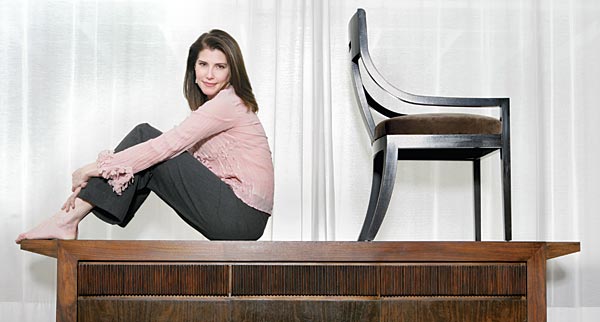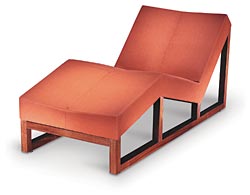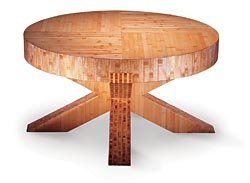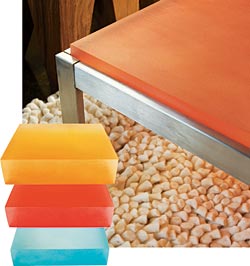 |
|
Salisbury and her Lyra chair perch atop her Pegasus buffet, shown here in walnut with a natural lacquer finish. |
Dismiss sustainable design as a trend du jour, and Jill Salisbury is likely to set you straight-albeit politely. "The movement is not a trend; it’s an awakening," declares the founder of Barrington-based green furniture company EL: Environmental Language (available through interior designers at Design Atelier, 1848 Merchandise Mart, 312-822-0440; el-furniture.com). "It wouldn’t surprise me if, in five years, green design becomes the definition of good design. It’s no longer going to be just an alternative."
That’s thanks to people like Salisbury. While working as an interior designer six years ago, she was frustrated by the dearth of home furnishings that were both beautiful and potentially compostable. So she developed her own line in 2004, and promptly earned two top design awards from the American Society of Interior Designers. Recently, she launched a line of green kitchen cabinets, one of only a handful available in the United States. We figured, who better to enlighten us on the particulars of going green?
 |
|
Salisbury’s Origami chaise, available in a variety of frames |
How do you define green design? There are many ways to be green. At EL, we make all of our furniture from natural materials, most of which we get locally-within a 500-mile radius [to reduce fuel use]-and it has to be low- or no-V.O.C. [volatile organic compounds, typically outgas from paints, finishes, and adhesives, which the EPA says can cause health problems]. A manufactured material-such as plastic-that can be recycled back into itself without ending up in a landfill is also green, but with high-end furniture, I really felt the need to use natural materials.
Bamboo seems to be a green material that’s very hot right now. Is it all it’s cracked up to be? Bamboo is a renewable material; it’s considered a grass, and it grows back within five to seven years. But it comes from Asia, so it has to be shipped. And if you put a lacquer on it that has V.O.C.s, then you’ve pretty much stripped the value other than the fact that it was harvested responsibly.
But you must put some sort of finish on your wood. What’s different about the finish you use? Our finish is a natural product derived from tree sap. It was originally developed for flooring, so it’s extremely durable. It has zero V.O.C.s. I’m smelling a sample now, and it has absolutely no odor.
So your furniture is good for the environment and good for our health. Can a product be one without being the other? Sure. Wool is natural, but a lot of people say wool is itchy and uncomfortable against the skin. That’s partly because the wool has been chemically treated. Organic wool has a different feel. I love using it for upholstery because it’s inherently flame-resistant, it wicks away moisture, and it’s soil-resistant. The chemical developed for flameproofing was developed to mimic wool. Well, why not just go with untreated wool?
 |
|
The Tian coffee table made of bamboo. |
When it comes to upholstery, how much more does a basic "green" fabric cost than, say, a conventional silk, cotton, or wool? Upholstery fabric made from organically grown natural fibers that don’t have any chemical treatments but still have durability are about $70 a yard [54 inches wide].
What questions should we ask when shopping for healthy furniture? What types of finishes are being put on the wood? Is there any kind of chemical treatment being put on upholstery? Does the core construction have any formaldehyde, either in its materials or in the adhesives?
What are some of the materials you use that really give owners bragging rights about doing their part to save the world? The palm-wood inlay in the Pava bistro table, which has a beautiful, unusual grain, for one. It’s a byproduct of the coconut industry. These palm trees get so tall that nutrients can’t get up to the fruit, so they take the trees down; we’re taking this plantation waste and using it. And the tagua nut, which is too hard to eat. It’s a readily renewable material that mimics ivory; we use it as an inlay. Then there’s a cork fabric that’s really beautiful. I could see it on ottomans. We’re still assessing it, though-the facing is 100 percent cork, but I don’t know what the backing is.
Are veneers a good thing? Do you use them in your kitchen cabinets? We use veneers whenever possible. You’re not using the whole tree; you’re using a skin applied to a substrate. If the veneer isn’t Forest Stewardship Council–certified, which assures the buyer that the wood was harvested responsibly, we typically use a domestic wood so we know it came from a forest that had more regulation, not a rainforest where we’re not sure what the logging practices are. In our kitchen cabinets, we’re offering rift-cut oak from local trees that have to come down anyway, German beech from a sustainable resource, and bamboo. Generally, the door is veneer, and the substrate and the box construction are FSC-certified.
 |
|
Salisbury is a fan of Chroma, a recycled resin product manufactured by 3form. |
What’s a green countertop material that can also take a beating? Is Corian considered green? I can’t endorse Corian’s raw materials or manufacturing process as being green; however, once it’s installed, there’s no offgassing, it doesn’t harbor mold or bacteria, and it can be refinished or repaired so that it will last a lifetime. I love Chroma, a beautiful resin product from 3form. At the end of its useful life, 3form will pay the cost to ship it back to them, and recycle it into a new countertop.
What is a good way to start greening one’s home without breaking the bank? EL can reupholster existing furniture using environmentally friendly fabrics. Use low-V.O.C. paints. Any Benjamin Moore or Duron paint dealer can provide you with low-V.O.C. paint for about the same cost as regular paint. For flooring, Flor is my favorite; you can send the carpet tiles back after they’ve been used, and Flor recycles them. Install cabinetry that doesn’t have V.O.C.s. All of our raw materials are culled from sustainable resources, and our finishes are nontoxic, which promotes healthier indoor air quality.
Photography: (image 1) Katrina Wittkamp, (image 2, 3, & 5) Jeff Schindler, (image 4) Skylar Nielsen
The Green Go-To Guide
Salisbury’s favorite sources:
Enviroglas Countertops, flooring, landscaping materials. Available through Greenmaker (see below). enviroglasproducts.com.
Fire & Water Eco-friendly lighting that’s also energy efficient, made from recycled and salvaged materials. cyberg.com/fw/fw.htm.
Flor Modular carpet tiles (flor.com). Available at Ambiente Collection, 233 W. Huron St., 312-951-9880.
Greenmaker Building Supply Paints, stains, flooring, countertops, tile, drywall, landscaping materials, and more. 2500 N. Pulaski Road, 773-384-7500, greenmakersupply.com.
Indika Organics Bedding and bath linens (indikaorganics.com). Available at Verde, 2100 W. Armitage Ave., 773-486-7750, verdedesignstudio.net.
Maharam Fabrics. maharam.com.
Teragren Bamboo flooring (teragren.com). Available at Home Carpet One, 3071 N. Lincoln Ave., 773-935-9314.
3form Countertops, backsplashes. 656 W. Randolph St., 800-726-0126, ext. 2652, 3-form.com.
Green-oriented designers:
- Mary Jane Derex Design, 847-965-8484
- Paula O’Connell, interior designer, 708-703-2168
- Nathan Kipnis Architects, 847-864-9650


